Metro Takes Another Step Forward in Effort to Build and Preserve Affordable Housing at Transit Hubs
1:42 PM PDT on April 2, 2015
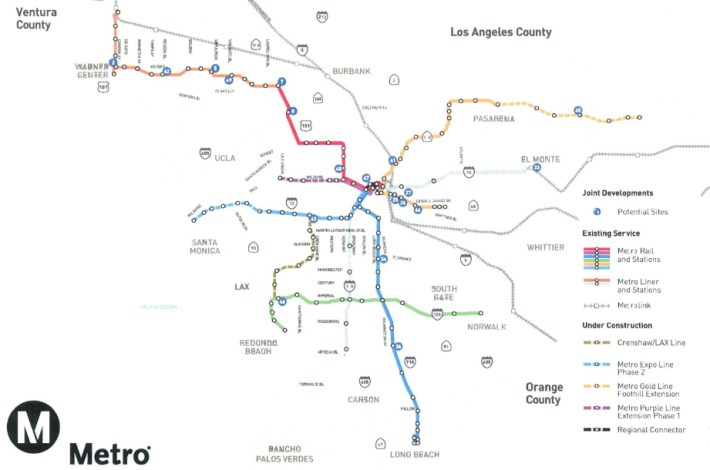
In case you haven't heard, we're in a bit of an affordable housing crunch.
According to the L.A. Times, "the city recently estimated that 82,000 additional affordable units will be needed by 2021."
Non-profit developers have been aware of this problem for some time. Approximately 8000 families applied for the 184 units of affordable housing that the East L.A. Community Corporation has built in Boyle Heights and East Los Angeles recently. 1500 families vied for a spot in the 60-unit residence on Whittier Bl. built by the Retirement Housing Foundation last March. And RHF was expecting as many as 2500 applications for the affordable, 78-unit senior residence set to open next door. More than 1000 families applied to live in a 90-unit residence in Macarthur Park built by McCormack Baron Salazar on land owned by Metro. And these figures likely don't include the folks who are desperate for housing but do not earn the minimum amount required to qualify for consideration.
But even as the need for affordable housing grows, the city's ability to provide and maintain it has declined significantly. Since 2008, funding for the city's Affordable Housing Trust Fund (AHTF) has dropped from $108 million to approximately $26 million. And, despite Mayor Eric Garcetti's vocal support for affordable housing, no new funds were allocated to the AHTF in the last budget. While L.A. will likely receive some of the (anticipated) $130 million in funds set aside for affordable housing from the first year of cap-and-trade, the funds will first need to be divvied up among municipalities across the state.
Which is why it was heartening to see the Metro Board move forward on its plans to set aside at least 35% of units built on Metro-owned land for affordable housing and to establish a fund to assist non-profit developers in building or preserving affordable housing on privately-owned land near transit.
It's not a panacea, as discussion of the 30-page staff report assessing the viability of the plan made clear. And there is much left to be done in the way of hammering out funding structures and sources for the loan fund or the criteria for discounts on Metro-owned land to entice developers to build affordable units. But it is a step in the right direction.
The report in question resulted from a November motion requesting that the California Community Foundation and the California Endowment assist Metro in preparing a study examining:
- Metro's inventory of current and potential joint development sites along Metro’s Gold, Expo, Crenshaw/LAX, Regional Connector, and Purple Lines.
- How Metro might partner with local municipalities to invest in transit corridor sites, potentially leveraging municipal housing funding.
- The viability of requiring 30%* of Metro’s jointly-developed housing to be affordable housing (to date, of the approximately 2,017 units built on 9 Metro-owned sites, 622, or 31%, are affordable units). *The number has since been amended up to 35%.
- Amending the existing Joint-Development policy to allow proportional discounts to the fair market value of MTA-owned property for the purpose of contributing towards the cost of affordable housing development.
- The creation of a Countywide Transit-Oriented Affordable Housing (TOAH) loan fund, potentially in collaboration with local Community Development Financing Institutions, that would facilitate the development, improvement, or preservation of affordable housing within a 1/2 mile of a rail or Rapid Bus stop.
- Establishing a TAP purchase program for residents of joint-development housing.
The report came down in favor of the policy, citing studies showing that those of modest income living near transit are more likely to use it and do so with greater frequency than wealthier residents would. It also underscored the importance of such a policy by acknowledging that the rising costs of housing near transit and the reduction in federal and state funds available for affordable housing could both displace poorer transit-dependent residents and, in doing so, inadvertently make them more car-dependent.
The study identified 19 potential Metro-owned sites for redevelopment, 10 of which it scored as viable for housing (listed below, and mapped out above). Those with low scores were seen as infeasible for housing due to size, location, or other constraints.
The report also suggested that Metro pursue a portfolio-wide approach to affordable housing rather than a project-oriented one. Ensuring that the total number of units across projects met the 35% benchmark instead of trying to build affordable units at each site would likely be more cost-effective and ensure that Metro would see a stronger revenue stream from market-rate units at the costlier sites. The approach would also make it easier for communities in need to see higher percentages of units dedicated to affordable housing and for others who did not value affordability in new projects to limit the number of affordable units available.
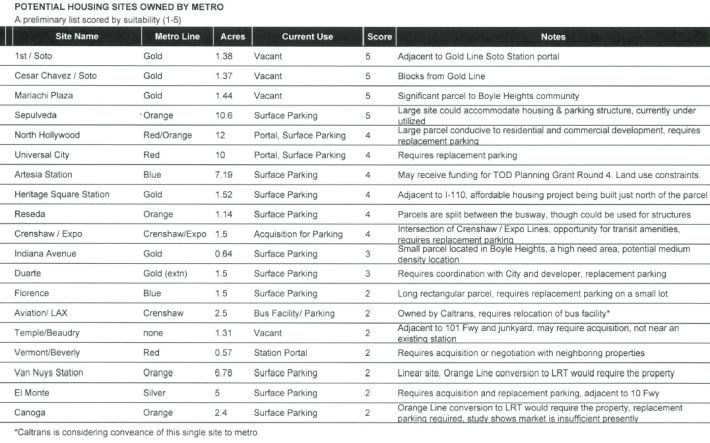
Among the boardmembers, the housing policy appeared to have a wide base of support.
In his opening remarks on the agenda item last Thursday, Mayor Garcetti strongly endorsed the idea of Metro playing a greater role in preserving the affordability of transit-oriented communities. Underscoring the findings of the report, he said that, given that approximately 80% of Metro's ridership hails from households earning less than $50,000 annually, it was important to ensure those residents' continued access to transit by prioritizing affordability and the prevention of displacement around transit.
A number of boardmembers also expressed their support for the policy. Hilda Solis only asked that community engagement be considered essential to the process of planning for the Metro-owned sites, citing its importance in understanding how gentrification and displacement can impact poorer communities.
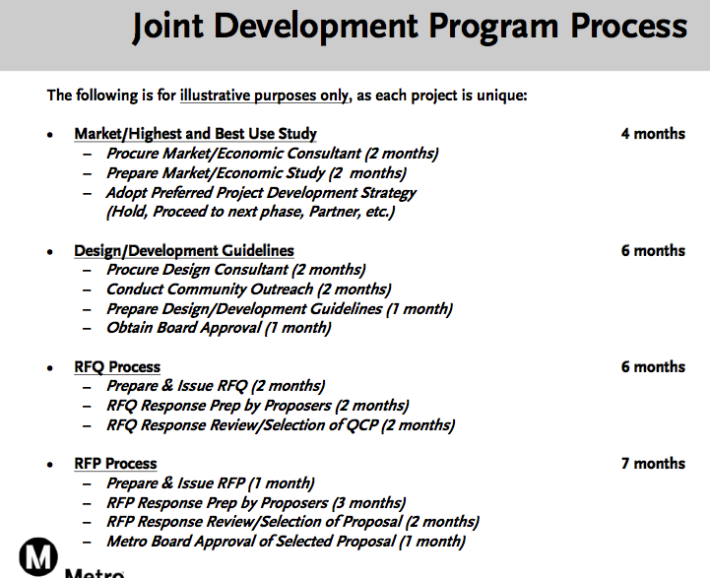
Unsurprisingly, some boardmembers got hung up on the question of how to create the Transit-Oriented Affordable Housing fund to support projects on non-Metro-owned property (details of how the fund might be set up begin on p. 25).
The report suggested that, using funds sourced from the General Fund, a revolving $2 million TOAH fund (paid into for five years, up to $10 million total) could aid potential non-profit and community developers in acquiring the "long-term, patient, higher-risk, flexible capital" that local lenders do not have the capacity to supply. Such funds could be used to "jump start" development activity within a 1/2 mile of transit sites in some neighborhoods, purchase, preserve, or rehab (or just plain hang on to while other loans are secured) de facto affordable housing under pressure from rising property values, promote "early start" projects (projects in existing affordable project pipelines that could be launched with a low per-unit investment and paid back quickly), and support mixed-income and/or mixed-use projects that could provide some affordable housing without deep subsidies.
Given the "looming operational deficit," Boardmember Diane DuBois wanted to be reassured that the General Fund -- the source of Metro's operating budget -- would not be harmed. Arguing it was important not to add to the strains on the system or dilute its ability to perform its core function of supplying transit, she asked that the CEO report back regarding the feasibility of establishing the TOAH fund using sources outside the General Fund and how such a fund might be distributed so as to ensure geographic equity.
Boardmember Don Knabe concurred, citing his support for the housing policy, but encouraging Metro to protect the General Fund and to spread TOAH funds throughout the county. (DuBois' motion was later amended to ensure that Metro studied the feasibility of drawing from both the General Fund and outside sources).
Boardmember Jackie Dupont-Walker, on the other hand, seemed confident that not only could a TOAH be funded without unduly harming the General Fund, but it could and should be used for more than housing.
Neighborhoods should not have to wait until after transit lines arrive to see their dreams realized, she argued. To that end, she moved that the Board look into developing a wider range of funding sources that could be leveraged against the resources available for transit and housing to simultaneously foster the growth of small businesses. Such an approach could prepare communities to take advantage of the benefits completed transit-related projects would bring, setting the stage for more equitable development. (An amendment was also added to include a study of the feasibility of supporting small business in the follow-up report.)
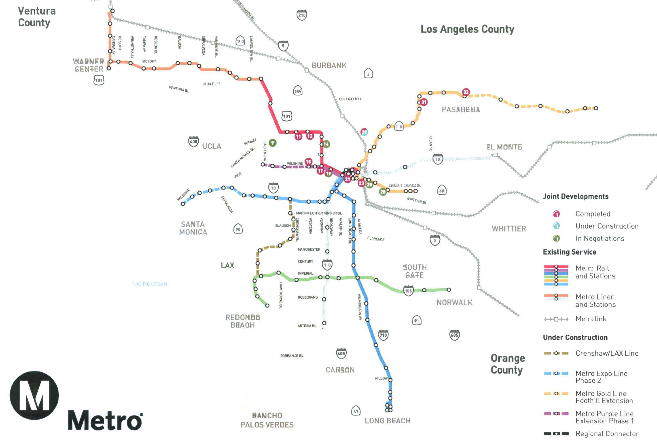
For the community organizers from Union de Vecinos and Proyecto Pastoral that had attended the meeting to express concerns about the policy, a few questions remained unanswered.
Their greatest concern was that the housing policy will struggle to aid the very folks that need it most.
As discussed in-depth here, when federal funds are used to build local housing, the accompanying federal guidelines can unintentionally shut thousands of lower-income transit-dependent households out of the running for a spot in a new development. The guidelines calculate rents and maximum and minimum income requirements using the Area Median Income (AMI) of L.A. County -- $81,500. By that scale, a family of two or more people would need to earn a minimum of $16,500, $22,020, or $27,510 (depending on the set-aside, below) to qualify for a unit. But in lower-income communities like Boyle Heights, where Metro has five affordable housing projects on the slate and the median income is only $33,325, thousands of needy families will both be unable to access the units and subjected to the very pressures of rising property values/rents that Metro cited as a major concern in its own report.
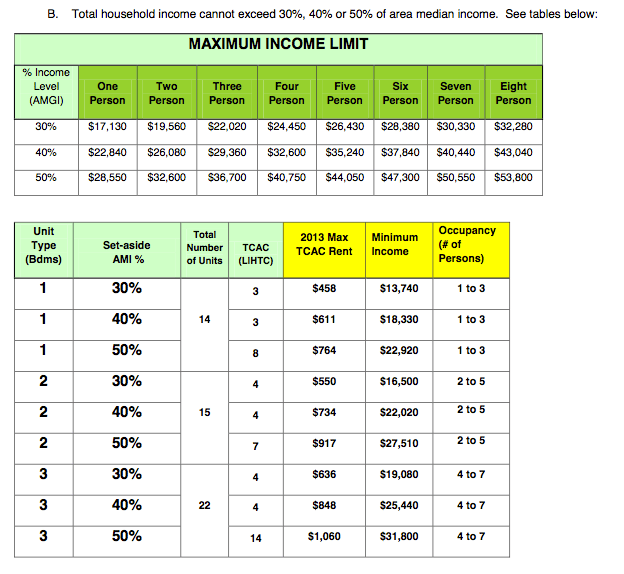
Acknowledging the affordability of affordable housing was indeed a problem, Boardmember Mike Bonin asked outgoing Metro CEO Art Leahy if Metro would have the opportunity to structure the loan fund in such a way as to prioritize low- or very-low income housing.
Leahy responded that staff would report back with a proposed structure and potential funding partners for the TOAH fund. If the board wanted to seek the lowest possible level of affordability for projects, he said, then they would attempt to negotiate a structure with funding and development partners to do that. That approach would likely require that Metro make additional funds available to the TOAH fund, he added, but "if that's the Board's priority, then that's what we would seek to attain."
Another issue raised during the discussion but not addressed in depth was that Metro may not have a good handle on how people -- specifically those living in transit-oriented affordable housing -- use or might use transit. In the communities of South L.A. and Boyle Heights, for example -- two communities where Metro has identified multiple potential housing sites -- people tend to use the bus over rail. Or they may use a mix of modes to get around, if they have multiple destinations or unusual schedules (e.g. work overnight shifts when transit either isn't running or isn't running as frequently). Facilitating the development of housing adjacent to a train station may therefore not be resolving residents' transit needs or adding significantly to the ridership base. Especially if, as Metro staff concluded, for every $2.5 million of General Fund money used for the TOAH fund, "a reduction of 10 operating buses would be required."
Knowing more about the habits of existing and potential residents could help in crafting more successful policy -- particularly in determining which projects might be best served by a TOAH loan and the kind of TAP purchase program (proposed as part of the housing policy) might best serve residents in new projects.
In the end, the Board concluded by receiving and filing the report and approving motion 51.1 (with the amendments by Boardmembers DuBois and Dupont-Walker noted above). Metro's CEO will be reporting back during the fiscal year 2015-2016 budget discussion with recommendations on how to structure the loan fund, discounts for Metro-owned land, the TAP purchase program, and Memoranda of Understanding with local municipalities to facilitate the development of affordable housing on Metro-owned property.
Given the uncertain timeline, that CEO may be Phil Washington, who will take up the reins at Metro in May. If so, we may have some interesting proposed solutions to look forward to. Washington oversaw similar policies aimed at carving out space for what he refers to as "Transit-Oriented Communities" in Denver and is said to have had a strong and personal commitment to ensuring the system is equitable.
In the meanwhile, we'll be exploring what this policy could mean for developers, communities, and transit-oriented development, including efforts to ensure equitable transit-oriented development along the Crenshaw Line.
Sahra is Communities Editor for Streetsblog L.A., covering the intersection of mobility with race, class, history, representation, policing, housing, health, culture, community, and access to the public space in Boyle Heights and South Central Los Angeles.
Stay in touch
Sign up for our free newsletter
More from Streetsblog Los Angeles
Metro Board Funds Free Student Transit Pass Program through July 2025
Metro student free passes funded another year - plus other updates from today's Metro board meeting
Eyes on the Street: New Lincoln Park Avenue Bike Lanes
The recently installed 1.25-mile long bikeway spans Lincoln Park Avenue, Flora Avenue, and Sierra Street - it's arguably the first new bike facility of the Measure HLA era
Brightline West Breaks Ground on Vegas to SoCal High-Speed Rail
Brightline West will be a 218-mile 186-mile-per-hour rail line from Vegas to Rancho Cucamonga - about 40 miles east of downtown L.A. - expected to open in 2028




